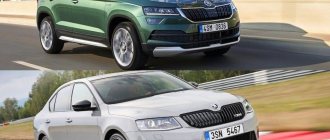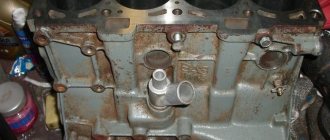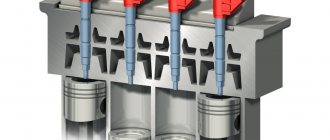The first 1.2 liter three-cylinder petrol power units. from VAG came out in 2002. The release dragged on for more than 10 years and ended only in 2015. Both two-valve and four-valve models were produced. The minimum power is 54 horsepower, the maximum is 70. Engines with 3 cylinders received the same cylinder blocks and cylinder head, but the attachments are different.
Engines were produced under the abbreviation HTP, which stands for High Torgue Performance - a motor with high torque. 1.2-liter power units received a power of 106-112 hp. at 3 thousand Nm. The three-cylinder engine is quite enough for small cars like the Fabia. But, according to drivers, the power unit cannot be called economical.
Watch on the AutoStrong YouTube channel a disassembly of the 1.2 HTP engine used in a Skoda Fabia with a mileage of 145 thousand kilometers.
You can order a contract Skoda engine from the AutoStrong catalog.
Are the coils and spark plugs reliable?
The engine received unreliable coils and spark plugs. Spark plugs quickly become covered with deposits if you constantly drive at idle and drive slowly in traffic jams. As a result, misfires occur, and over time the ignition coils must be replaced.
Errors indicate that there are problems with the ignition. In addition, with such problems, power drops and vibrations occur. The cylinder will work properly only after restarting the power unit, but soon the problem will arise again.
To make sure that the problem is in the coil, you need to check the operation of the motor after starting: if it idles at idle, and when the coil connector is disconnected, the behavior remains the same, then the cause of the malfunction is in the coil.
It is recommended to immediately go to a service station, first turning off the injector in the cylinder with the failed coil.
You can purchase original ignition coils for the Skoda 1.2 HTP, Volkswagen 1.2, Seat 1.2 engines in the catalog on our website.
History of creation and production
In 1990, the Skoda Auto concern became the fourth world-famous brand - a member of the automotive family of the German auto giant Wolksvagen. At the request of the parent company, the Czechs discontinued the Felicia model in 2001. The new “face” of the company was the model presented in the fall of 1999 at the motor show in Frankfurt, Germany. "Amazing"! That’s exactly what its creators called the new product, looking back at the Latin word fabulous.
- 1st generation (1999-2007).
The Fabia car of the “first convocation” rolled off the assembly line under the code Mk1. The car, designed on the basis of the German A04 platform, received the name traditional for all Czech-made cars (with the ending “ia”). The engineers did not limit themselves to the production of hatchbacks, and at the auto show in Paris (September 2001) they presented another option to the demanding public - the Fabia Combi station wagon, and in Geneva - a sedan.
Fabia’s “relatives” cars are WV Polo and SEAT Ibiza. The designers installed a wide variety of engines on them - from gasoline 1.2 liters. AWV to the most powerful 2-liter turbodiesels ASZ, ASY and AZL. The only Czech-made engine in the first generation of Skoda Fabia cars is the 1.4-liter AUB MPI unit, modified since the release of the Favorit and Estelle models, back in the “Don-German” period of the existence of the Skoda Auto concern.
The design team turned out to be very prolific in updating. Following the machines that had already entered the market, the following appeared:
- Fabia Junior hatchback;
- utility station wagon Fabia Praktik.
In 2004 and 2006, the car underwent limited restyling. The degree of popularity of the 1st generation car among European consumers is evidenced by the sales figure - 1.8 million units.
- 2nd generation (2007-2014).
With the start of production of the next generation of cars, the company abandoned the sale of sedans, and completely focused its efforts on perfecting the design of hatchback and station wagon cars. As a result, in 2009, cars with a plastic body kit, assembled in the Scoult configuration, from the Czech designer F. Pelikan appeared.
A distinctive feature of the new line of cars is the installation of an “advanced” transmission. Instead of an automatic transmission, engineers proposed the use of a 7-speed DSG robotic gearbox in a power plant with TSI turbocharged internal combustion engines.
The Czech automaker has also succeeded in another direction. The designers developed the RS sports car. The engine installed on it with a double turbocharger developed a power of 180 hp. The maximum speed of the car was up to 225 km/h. In addition to the power plant, it has a number of unique new products:
- 17-inch Giugiaro alloy wheels;
- rear bumper with installed dual exhaust and diffuser;
- sporty design seats;
- stainless steel pedals.
Until 2014, the 2nd generation Skoda Fabia was assembled using the large-knot method at an automobile plant in Kaluga. And besides, in China, India, Ukraine, and some other countries. The price of a Russian-assembled car in the basic configuration was 339 thousand rubles.
- 3rd generation (2014-present).
The world does not stand still. Unique IT technologies are rapidly being implanted into cars. The new Fabia is a MirrorLink space in which passengers' smartphones are seamlessly linked to the audio multimedia system and navigation computer. The power plants have also undergone a radical update. The outdated layouts are replaced by new ones, created on the basis of the proprietary MQB concept - engines with variable valve timing systems and fuel injection according to MPI and TSI schemes, start-stop and a recovery system.
The third generation hatchback was presented in Paris in August 2014. The sporty layout style is called Vision C. It is distinguished by elegant headlights, a large number of angles, making the car look like a crystal, shimmering in bright light. Proportionally, the car has become wider and lower than its predecessor.
The cabin now has much more space for the driver and passengers: it has grown by 8 mm in length and 21 mm in width. The 330-liter trunk is 15 liters more spacious than before. The rear seats are equipped with a convenient folding system, on which cargo over one and a half meters long can be placed for transportation.
The car costs 11.8 thousand euros (as standard) and is assembled at the Skoda car plant in Mlada Boleslav. The advanced TSI and MPI power plants are equipped with a manual or preselective robotic gearbox. Deliveries of the vehicle to the Russian Federation are not provided.
How often should you clean your throttle body?
If an error occurs due to a lean mixture, and the engine stops when idling and becomes dull in response to the gas, the throttle valve needs to be cleaned. The damper requires adaptation after removal; for this you need proprietary software (manipulating the key and ignition switch is quite enough).
You can purchase an original used throttle body for the Skoda 1.2 HTP, Volkswagen 1.2, Seat 1.2 engine in the AutoStrong catalog.
IMG_2785
Artem MELNICHUK, director of used car sales salon
I love dealing with the second generation Fabia. It is very reliable, and the condition of these machines is usually good - and such machines do not stay on the site for long. If there is a need to repair something, it will not require large investments.
Buyers love the Fabia most for its decent ground clearance (more than 150 mm), excellent road behavior and, what is also important, for its timeless design. Like most Volkswagen models, the second Fabia gives the impression of a well-built and “finished” car. You don’t have to lower the price too much - it will still sell without any problems in a month or a month and a half, despite the fact that the equipment is poorer than competitors from Asia.
WORD TO THE OWNER
Features of the VKG valve
The 1.2 HTP engine received an unremarkable valve for the crankcase ventilation system. Its failure is mainly caused by the destruction of the membrane. The problem will immediately begin to be signaled by uneven operation of the power unit at idle. Also, if the membrane breaks, excess gas pressure escapes through the neck.
It is undesirable to ignore problems with the VKG valve, as this will lead to misfires and high oil consumption. The cost of the membrane is low, but instead of replacing it, it can be repaired by installing a non-original membrane.
It is noteworthy that it was the 1.2 BMD engine that received a defective valve, which caused ventilation problems. The valve was replaced under warranty.
The ideal engine for Skoda Fabia
At the very beginning of 2012, in honor of the 110th anniversary of the first participation of the Skoda car in sports rallies, a new version of the Fabia Monte Carlo was rolled out. The basis of the power plant was a unique 1.6-liter turbocharged diesel engine from the German concern VAG with a power of 105 hp. The engine marked CAYC is part of the EA189 series. It is designed to replace a two-liter diesel engine. To reduce the working volume to 1.6 liters. engineers reduced the cylinder diameter (from 81 to 79.5 mm) and the amount of free play of the pistons.
The engine with an engine capacity of 1598 cm3 is equipped with a traditional diesel common rail direct fuel injection system from Continental and a Siemens Simos PCR 2.1 electronic control unit. The list of advanced technologies used in the design of the unit is truly impressive:
Each cylinder has two valves for intake and exhaust. The camshafts are driven from the crankshaft using a toothed belt. The shapes of the inlet (oval) and outlet (spiral) channels help improve the process of formation of the fuel mixture. The maximum fuel pressure supplied to the system is 1600 bar. The movement of the valves is carried out using roller rocker arms. To adjust the thermal gap, hydraulic compensators are installed on the valves.
Fuel consumption figures for cars like Fabia, Golf and Ibiza are respectable:
During the operation of an engine designed to meet European environmental standards Euro 5 (maximum emissions - 109 g/km), special attention should be paid to the exhaust gas recirculation valve after 150-200 thousand km. mileage Regeneration during operation of the diesel particulate filter is stopped if potentiometer G212 fails (error code 7343). The cause of the failure is wear of the damper bearing, as a result of which the ECU no longer “sees” its initial position.
The engine has an extremely high degree of reliability. Engine manufacturers declared a warranty life of 250 thousand km. In practice, it exceeds 400 thousand km, and is ideal for medium and small class cars. Thus, on a Wolksvagen Caddy, the CAYC engine covered 600 thousand km before replacement without costly repairs.
And another significant advantage of the engine is that it responds well to firmware when tuning. Stage 1 firmware gives power up to 140 hp. and torque at 300 Nm. More serious work with the “internals” (additional filter, downpipe) gives another ten “horses” and plus 30 Nm of torque. It is possible to replace the turbine with a more powerful one, but in cars like the Skoda Fabia this is impractical.
Source
Why does the timing chain skip?
In three-cylinder VAG engines, unfortunately, chain jumping is not uncommon. Six-valve power units will survive a jump of a couple of teeth; valves and pistons will not collide. But the sixteen-valve version of the engine will not survive any jump.
On this engine, chain stretching occurs after 50 thousand kilometers. To make sure when purchasing a motor that the chain is not stretched, you need to listen to the operation of the power unit after a cold start. If clanging and knocking noises are present, the chain is stretched.
It is recommended to change the chain regularly (after 70 thousand kilometers), as well as when buying a used car.
When operating a 1.2 HTP vehicle, it is not recommended to leave the vehicle parked in gear, especially when tilting backwards. Since there is no counter-travel stopper in the hydraulic tensioner, there is a high risk of the chain sagging while parked.
To increase the service life of the power unit, it is recommended to change the oil after 7,000 - 8,000 kilometers. Since the engine contains only 2.8 liters of oil, it quickly loses its properties.
Features of hydraulic chain tensioners
The engineers who developed this motor made a number of serious mistakes with guide bars and hydraulic tensioners, which caused the death of more than one motor. Experts recognized the shortcomings and sought to correct them.
After starting the power unit, noise may occur from the timing belt. Their source is the hydraulic tensioner: the knocking occurs either because of the tensioner piston or because of its bar hitting the body.
In 2003 and 2005, modified guide bars and hydraulic tensioners were produced, including re-complexes with modified parts.
Owner reviews
Skoda Fabia owners highlight its good appearance and body quality. It is impossible not to note its small dimensions, which make it very mobile in city traffic. Drivers choose this car because of its reasonable price, good efficiency, level of comfort and good safety. The suspension works well on our roads.
However, the owners also note some disadvantages associated with insufficient noise insulation, a harsh suspension, and a small trunk. It's a little cramped inside, and very slow acceleration doesn't allow you to feel confident on the road. In all other respects, this is a good car for the money, with an eye on Volkswagen products. The latest generation allows you to significantly increase the chances of the Skoda Fabia 3 in the classmates market.
Why do valves burn out?
The first engine models (until 2010) were very sensitive to the quality of gasoline used. Poor quality fuel could cause the engine to trip and drop compression, which led to the valves not fitting tightly to the seats in one of the cylinders.
Low-grade gasoline also leads to the destruction of the catalyst: it becomes clogged, causing the exhaust valves to overheat and burn. The valve stems and their guides wear out. Mostly, such problems in the cylinder head occur in one of the cylinders. When starting the engine, it is recommended not to tighten it and immediately check the compression.
Features of earbuds
The 1.2 HTP engine block is made of aluminum alloy, with cast iron liners. The block is divided into 2 parts along the crankshaft axis. According to the repair instructions, the lower part of the cylinder block must not be removed, as this may lead to deformation of the main liner bed. Because of this, the plant does not produce for sale original main bearings of the nominal size for this engine.
But there are some pretty good repair sized inserts on sale. In addition, as practice shows, the bed does not deform when the block is halved, overhauled and put back together.











